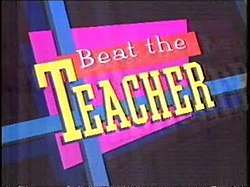Beat the Teacher
Beat the Teacher is a British children's game show that aired on BBC1 from 24 September 1984 to 27 October 1988. It was first hosted by Howard Stableford in 1984, then hosted by Paul Jones from 1985 to 1986 and finally Bruno Brookes from 1987 to 1988.
| Beat the Teacher | |
|---|---|
 | |
| Genre | Children's Game show |
| Created by | Clive Doig |
| Presented by | Howard Stableford (1984) Paul Jones (1985–6) Bruno Brookes (1987–8) |
| Country of origin | United Kingdom |
| Original language(s) | English |
| No. of series | 5 |
| No. of episodes | 164 |
| Production | |
| Running time | 30 minutes |
| Release | |
| Original network | BBC1 |
| Picture format | 4:3 |
| Original release | 24 September 1984 – 27 October 1988 |
Show format
Each edition featured two contestants; one a school student and the other a teacher. Both were tested on general knowledge questions and logic puzzles.
Correct answers won the contestant moves on a giant Noughts and Crosses board made from rotating cubes. Questions awarded one, two or three moves of the board, based upon their difficulty. Control of the board was determined by the use of buzzers. After answering the question correctly, the contestant was given the choice of which blocks on the board to turn over.
For example, if a square displayed a "nought", one rotation would see the square turn blank; two would see it replaced with a "cross", three with another blank and on the fourth turn it would revert to a "nought".
Tactical play would lead to the contestant building up lines of noughts or crosses, for which points were awarded (10 points per horizontal, vertical or diagonal line).
A special "joker card" could be played once in each game by either contestant, reversing each square on the board so that all crosses became noughts and vice versa. A bonus was awarded for a full board of noughts or crosses, after which each square on the board would be randomised.
Question styles generally included puzzles, "true or false," or "identify the picture". The last round of the show before the winner was declared was a special "wrong answer round" in which aim was for the contestants to give as many incorrect answers as they could within 60 seconds. Each "wrong" answer would earn the contestant a move on the board, while if they gave answered a question correctly then they would lose one move per "correct" answer; in order to avoid deliberate tactical play, a twist was added so that if the contestant said "pass" instead of attempting to answer the question, then they would immediately lose all of their moves gained up to that point and have to start again from "zero" with any time remaining.
The player with the highest score at the end would be crowned champion and participate in the "final" round. The board was cleared, and the winning contestant had to try to fill all nine squares up by answering nine questions correctly within 60 seconds. If they accomplished this, they would win a prize. Whether they won or not they were invited to come back again the next episode. A "Beat the Teacher" Failure Mug was the consolation prize awarded to a majority of the show's unsuccessful contestants.
Once a contestant won five games in a row, they would "retire" undefeated (although this rule was waived for the final series, which saw one contestant win thirteen episodes in a row before being defeated). The best four students and the best four teachers from each series in terms of total number of wins and then total scores achieved in their episodes (excluding the final round) would return for the quarter finals at the end of the series
Transmissions
| Series | Start date | End date | Episodes |
|---|---|---|---|
| 1 | 24 September 1984[1] | 9 November 1984[2] | 28 |
| 2 | 9 September 1985[3] | 8 November 1985[4] | 36 |
| 3 | 8 September 1986[5] | 7 November 1986[6] | 36 |
| 4 | 14 September 1987[7] | 12 November 1987[8] | 36 |
| 5 | 12 September 1988[9] | 27 October 1988[10] | 28 |
References
- "Beat the Teacher - BBC One London - 24 September 1984". BBC Genome Project. Retrieved 22 October 2016.
- "Beat the Teacher - BBC One London - 9 November 1984". BBC Genome Project. Retrieved 22 October 2016.
- "Beat the Teacher - BBC One London - 9 September 1985". BBC Genome Project. Retrieved 22 October 2016.
- "Beat the Teacher - BBC One London - 8 November 1985". BBC Genome Project. Retrieved 22 October 2016.
- "Beat the Teacher - BBC One London - 8 September 1986". BBC Genome Project. Retrieved 22 October 2016.
- "Beat the Teacher - BBC One London - 7 November 1986". BBC Genome Project. Retrieved 22 October 2016.
- "Beat the Teacher - BBC One London - 14 September 1987". BBC Genome Project. Retrieved 22 October 2016.
- "Beat the Teacher - BBC One London - 12 November 1987". BBC Genome Project. Retrieved 22 October 2016.
- "Beat the Teacher - BBC One London - 12 September 1988". BBC Genome Project. Retrieved 22 October 2016.
- "Beat the Teacher - BBC One London - 27 October 1988". BBC Genome Project. Retrieved 22 October 2016.